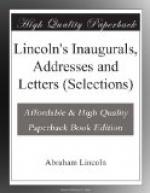But there is another difficulty. The great interior region, bounded east by the Alleghanies, north by the British dominions, west by the Rocky Mountains, and south by the line along which the culture of corn and cotton meets, and which includes part of Virginia, part of Tennessee, all of Kentucky, Ohio, Indiana, Michigan, Wisconsin, Illinois, Missouri, Kansas, Iowa, Minnesota, and the Territories of Dakota, Nebraska, and part of Colorado, already has above ten millions of people, and will have fifty millions within fifty years if not prevented by any political folly or mistake. It contains more than one third of the country owned by the United States—certainly more than one million of square miles. Once half as populous as Massachusetts already is, it would have more than seventy-five millions of people. A glance at the map shows that, territorially speaking, it is the great body of the republic. The other parts are but marginal borders to it, the magnificent region sloping west from the Rocky Mountains to the Pacific being the deepest and also the richest in undeveloped resources. In the production of provisions, grains, grasses, and all which proceed from them, this great interior region is naturally one of the most important in the world. Ascertain from the statistics the small proportion of the region which has, as yet, been brought into cultivation, and also the large and rapidly increasing amount of its products, and we shall be overwhelmed with the magnitude of the prospect presented; and yet this region has no seacoast, touches no ocean anywhere. As part of one nation, its people now find, and may forever find, their way to Europe by New York, to South America and Africa by New Orleans, and to Asia by San Francisco. But separate our common country into two nations, as designed by the present rebellion, and every man of this great interior region is thereby cut off from some one or more of these outlets—not, perhaps, by a physical barrier, but by embarrassing and onerous trade regulations.
And this is true wherever a dividing or boundary line may be fixed. Place it between the now free and slave country, or place it south of Kentucky or north of Ohio, and still the truth remains that none south of it can trade to any port or place north of it, and none north of it can trade to any port or place south of it except upon terms dictated by a government foreign to them. These outlets, east, west, and south, are indispensable to the well-being of the people inhabiting, and to inhabit, this vast interior region. Which of the three may be the best, is no proper question. All are better than either; and all of right belong to that people and to their successors forever. True to themselves, they will not ask where a line of separation shall be, but will vow rather that there shall be no such line. Nor are the marginal regions less interested in these communications to and through them to the great outside world. They, too, and each of them, must have access to this Egypt of the West without paying toll at the crossing of any national boundary.




